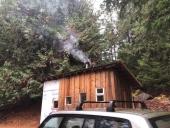posted 12 years ago
Hans Quistorff : I can only talk in a general manner, and then about where you say you used to live, Insulation on the inside of the Barrel would allow for higher
controlled burn temperatures, allowing you to become smokeless sooner.
The Triple wall pipe was acting like the highly insulated Heat Riser / internal Chimney in a Rocket Mass Heater, I expect that that section of triple wall pipe was
as hot as any triple wall stove pipe ever gets ! To say it burned efficiently is also clearly a given, but I expect that a great deal of the fast flowing hot exhaust
actually got a chance to radiate much heat into the room before it was exhausted out doors ! Yes, you should be able to see some large improvements in the
Amount of heat you could store with a Thermal mass Like Cob !
In the example you gave the main heat radiator was the Barrel. Cobbing that would hold additional heat internally within the barrel and cause the Barrel to fail
sooner, and more heat would go up the insulated chimney, some additional stove pipe mounted below the barrel stove containing a fan and a simple fan limit
switch monted up stairs to turn the fan off and on would scavenge a great deal more of the heat from the exhaust flue pipe !
IF, your stove pipe was brought up to the level of the second floor and then turned at right angles (?) to run horizontally above the 2nd floor, it could then
be wrapped in cob which would hold and then slowly release the heat rather than allowing so much of it to escape up the vertical chimney.
In a Rocket mass heater, we are lining the Burn Tunnel and Heat Riser with refractory materials that resist absorbing heat beyond the immediate surface layers,
glowing orange hot and promoting a high temperature, and a very efficient burn ! In this manner there is a similarity to the way the Heat Riser and your 16 foot
long vertical chimney were working ! The similarity ends there because at the point the R.M.H.s hot exhaust gasses hit the top of the barrel and fall down the
sides of the 55 gal drum they radiate off heat, become cooler, and sink, this force and aiding force helps to then 'pump' the exhaust gases 30 or more feet thru
horizontal pipes where it gives of much of its exhaust heat, usually in the 150 degree F range ! I hope this helps, and that you will want to learn more about high
efficient wood stoves !
For the good of the craft ! Your comments/questions solicited and Welcome ! big AL
riser with Ref
Success has a Thousand Fathers , Failure is an Orphan
LOOK AT THE " SIMILAR THREADS " BELOW !







